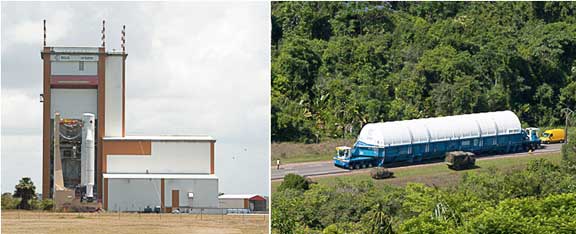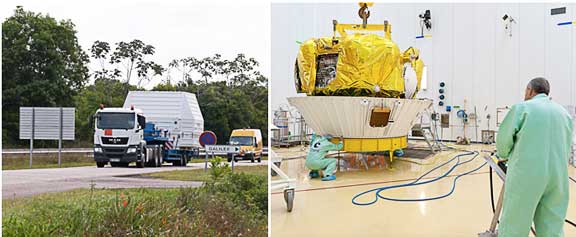...in preparation for Arianespace's upcoming flights from French Guiana, maintaining the company's mission pace in 2012. During separate activities on the same day, Flight VA209’s Ariane 5 was transferred from the Launcher Integration Building, where its basic assembly was performed, to the Final Assembly Building for installation of this mission’s two commercial relay satellites; while the vehicle for Flight VA210 was brought into the Spaceport after arriving by ship at nearby Pariacabo Port, completing a trans-Atlantic trip from Europe.
These concurrent developments underscore Arianespace’s mission flexibility with Ariane 5 that benefit from the Spaceport’s infrastructure, which is designed to support parallel launch campaigns with this workhorse vehicle.

The Ariane 5 for Flight VA209 approaches the Spaceport's Final Assembly Building, where Arianespace is to install the mission's ASTRA 2F and GSAT-10 satellite passengers (photo at left). In the photo at right, the container with Ariane 5's main cryogenic stage for Flight VA210 makes its way through the Spaceport after being delivered by ship to the nearby Pariacabo Port.
Photo courtesy of Arianespace.
The Flight VA209 Ariane 5’s transfer to the Final Assembly Building represented a new milestone in preparations for the next mission, as it marked the launcher’s delivery to Arianespace by prime contractor Astrium. Final steps under Arianespace’s responsibility will be installation of the mission’s two payloads—ASTRA 2F and GSAT-10—followed by the completed vehicle’s rollout to the ELA-3 launch zone, the final countdown and liftoff on September 21.
ASTRA 2F will be operated by Luxembourg-based SES and is configured with Ku- and Ka-band payloads for the relay of high performance DT) and next-generation broadband services to Europe, the Middle East and Africa. The spacecraft is a six metric ton-class platform based on Astrium’s Eurostar E3000 satellite bus.
The GSAT-10 passenger for Flight VA209 was developed by the Indian Space Research Organisation (ISRO) for Ku- and C-band relay services as part of the Indian National Satellite (INSAT) geostationary spacecraft system. With a liftoff mass of approximately 3,400 kg., this satellite is based on ISRO’s I-3K satellite bus.
Arianespace’s mission with GSAT-10 and ASTRA 2F will be the 65th flight of an Ariane 5 from French Guiana, and the 209th liftoff of an Ariane-series vehicle—which results in its VA209 designation (with the “V” representing the French word for “flight,” and the “A” signifying an Ariane member of the company’s commercial launcher family).
Additionally, the Fregat upper stage for Arianespace’s upcoming Soyuz launch from French Guiana has been moved to the Spaceport’s S3B facility, where...
...it will be fueled and integrated with the mission’s two Galileo navigation satellites. Fregat is an autonomous, highly flexible orbital vehicle that can be restarted up to 20 times in flight—enabling it to carry out a wide variety of complex mission profiles. Built by Russia’s Lavochkin Research and Production Association, the Fregat upper stage incorporates an array of six welded spherical tanks, with four spheres serving as the propellant tanks, while the other two operate as sealed instrumentation bays containing the flight control system, along with radio and telemetry systems.
The Fregat to be used on Arianespace’s next Soyuz mission from the Spaceport underwent its initial checkout at the launch site’s dedicated MIK vehicle assembly building for the Russian-built launcher, and was transferred by road this week to the S3B facility. To support Arianespace’s Soyuz launch activity in French Guiana, the S3B site has been configured for final preparation of Fregat upper stages, along with the mating of their payloads. This is the fueling location for Fregat, and it contains the integration stand where satellite passengers are installed atop the upper stage, along with the payload fairing.

Moving in a convoy (photo at left), the Fregat upper stage for Arianespace's third Soyuz mission at French Guiana is transferred from the Spaceport's MIK vehicle assembly building to the S3B facility (photo at right).
Photo courtesy of Arianespace.
The upcoming Soyuz mission is set for the second half of 2012, carrying two more In-Orbit Validation (IOV) spacecraft for Europe’s Galileo navigation satellite system. These two spacecraft are to join another pair of Galileo IOV satellites that were launched by Arianespace in October 2011 on Soyuz’ maiden flight from French Guiana. Having all four IOV spacecraft in orbit will enable the first computation of on-ground positioning based solely on Galileo satellites, marking a significant step in the European program. This will be followed by deployment of additional satellites and ground segment elements to achieve the Full Operational Capability status, allowing Galileo navigation and positioning services to be provided for users.
The Galileo IOV spacecraft are produced in a European industry consortium led by the Astrium division of EADS and Thales Alenia Space. Galileo is an initiative of the European Commission and European Space Agency, and is designed to create an independent global satellite navigation system for Europe—while also being interoperable with the U.S. GPS and Russian Glonass networks for enhanced combined performance. Arianespace is responsible for deploying the entire Galileo constellation of 30 satellites, using a mix of both its medium-lift Soyuz and Ariane 5 heavy-lift launchers.

